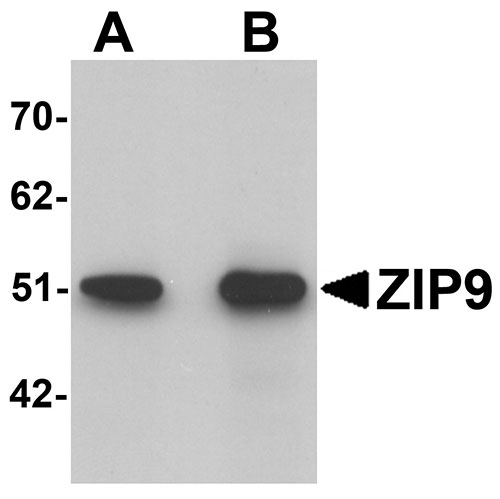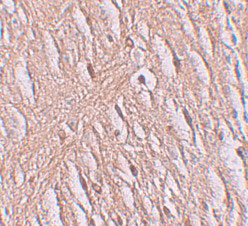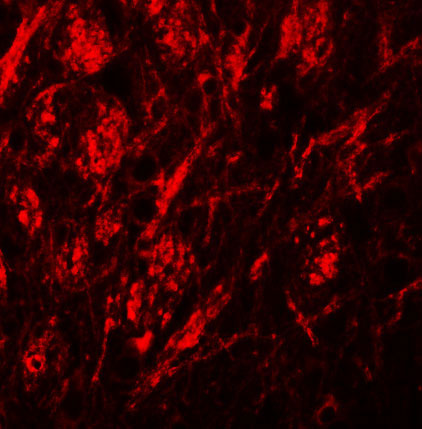ZIP9 Antibody
- SPECIFICATION
- CITATIONS
- PROTOCOLS
- BACKGROUND

Application
| WB, IHC-P, IF, E |
|---|---|
| Primary Accession | Q9NUM3 |
| Other Accession | NP_060845, 237874617 |
| Reactivity | Human, Mouse |
| Host | Rabbit |
| Clonality | Polyclonal |
| Isotype | IgG |
| Calculated MW | 32251 Da |
| Application Notes | ZIP9 antibody can be used for detection of ZIP9 by Western blot at 1 - 2 µg/mL. Antibody can also be used for immunohistochemistry starting at 2.5 µg/mL. For immunofluorescence start at 20 µg/mL. |
| Gene ID | 55334 |
|---|---|
| Target/Specificity | Slc39a9; ZIP9 antibody is predicted to not cross-react with other ZIP family members. |
| Reconstitution & Storage | ZIP9 antibody can be stored at 4℃ for three months and -20℃, stable for up to one year. As with all antibodies care should be taken to avoid repeated freeze thaw cycles. Antibodies should not be exposed to prolonged high temperatures. |
| Precautions | ZIP9 Antibody is for research use only and not for use in diagnostic or therapeutic procedures. |
| Name | SLC39A9 (HGNC:20182) |
|---|---|
| Synonyms | ZIP9 |
| Function | Transports zinc ions across cell and organelle membranes into the cytoplasm and regulates intracellular zinc homeostasis (PubMed:19420709, PubMed:25014355, PubMed:28219737). Participates in the zinc ions efflux out of the secretory compartments (PubMed:19420709). Regulates intracellular zinc level, resulting in the enhancement of AKT1 and MAPK3/MAPK1 (Erk1/2) phosphorylation in response to the BCR activation (PubMed:23505453). Also functions as a membrane androgen receptor that mediates, through a G protein, the non- classical androgen signaling pathway, characterized by the activation of MAPK3/MAPK1 (Erk1/2) and transcription factors CREB1 or ATF1 (By similarity). This pathway contributes to CLDN1 and CLDN5 expression and tight junction formation between adjacent Sertoli cells (By similarity). Mediates androgen-induced vascular endothelial cell proliferation through activation of an inhibitory G protein leading to the AKT1 and MAPK3/MAPK1 (Erk1/2) activation which in turn modulate inhibition (phosphorylation) of GSK3B and CCND1 transcription (PubMed:34555425). Moreover, has dual functions as a membrane-bound androgen receptor and as an androgen-dependent zinc transporter both of which are mediated through an inhibitory G protein (Gi) that mediates both MAP kinase and zinc signaling leading to the androgen-dependent apoptotic process (PubMed:25014355, PubMed:28219737). |
| Cellular Location | Golgi apparatus, trans-Golgi network membrane. Cell membrane; Multi-pass membrane protein. Cytoplasm, perinuclear region Mitochondrion. Nucleus |
| Tissue Location | Highly expressed in pancreas, testis, and pituitary and moderately in the kidney, liver, uterus, heart, prostate, and brain, whereas expression is lower in the ovary and colon |

Thousands of laboratories across the world have published research that depended on the performance of antibodies from Abcepta to advance their research. Check out links to articles that cite our products in major peer-reviewed journals, organized by research category.
info@abcepta.com, and receive a free "I Love Antibodies" mug.
Provided below are standard protocols that you may find useful for product applications.
Background
ZIP9 Antibody: The zinc transporter ZIP9, also known as SLC39A9, is a member of a family of divalent ion transporters. Zinc is an essential ion for cells and plays significant roles in the growth, development, and differentiation. The zinc transporter family is divided into four subfamilies (I, II, LIV-1 and gufA). ZIP9 is a multipass membrane protein that belongs to the ZIP transporter subfamily I. It is located at the trans-Golgi network regardless of zinc presence and is thought to be a zinc homeostasis regulator acting in the secretory pathway without significantly altering cytosolic zinc homeostasis.
References
Dufner-Beattie J, Langmade SJ, Wang F, et al. Structure, function, and regulation of a subfamily of mouse zinc transporter genes. J. Biol. Chem.2003; 278:50142-50.
Eide DJ. The SLC39 family of metal ion transporters. Pflugers Arch.2004; 447:796-800.
Taylor KM and Nicohlson RI. The LZT proteins; the LIV-1 subfamily of zinc transporters. Biochim. Biophys. Acta.2003; 1611:16-30.
Matsuura W, Yamazaki T, Yamaguchi-Iwai Y, et al. SLC39A9 (ZIP9) regulates zinc homeostasis in the secretory pathway: characterization of the ZIP subfamily protein in vertebrate cells. Biosci. Biotechnol. Biochem.2009; 73:1142-1148.
If you have used an Abcepta product and would like to share how it has performed, please click on the "Submit Review" button and provide the requested information. Our staff will examine and post your review and contact you if needed.
If you have any additional inquiries please email technical services at tech@abcepta.com.













 Foundational characteristics of cancer include proliferation, angiogenesis, migration, evasion of apoptosis, and cellular immortality. Find key markers for these cellular processes and antibodies to detect them.
Foundational characteristics of cancer include proliferation, angiogenesis, migration, evasion of apoptosis, and cellular immortality. Find key markers for these cellular processes and antibodies to detect them. The SUMOplot™ Analysis Program predicts and scores sumoylation sites in your protein. SUMOylation is a post-translational modification involved in various cellular processes, such as nuclear-cytosolic transport, transcriptional regulation, apoptosis, protein stability, response to stress, and progression through the cell cycle.
The SUMOplot™ Analysis Program predicts and scores sumoylation sites in your protein. SUMOylation is a post-translational modification involved in various cellular processes, such as nuclear-cytosolic transport, transcriptional regulation, apoptosis, protein stability, response to stress, and progression through the cell cycle. The Autophagy Receptor Motif Plotter predicts and scores autophagy receptor binding sites in your protein. Identifying proteins connected to this pathway is critical to understanding the role of autophagy in physiological as well as pathological processes such as development, differentiation, neurodegenerative diseases, stress, infection, and cancer.
The Autophagy Receptor Motif Plotter predicts and scores autophagy receptor binding sites in your protein. Identifying proteins connected to this pathway is critical to understanding the role of autophagy in physiological as well as pathological processes such as development, differentiation, neurodegenerative diseases, stress, infection, and cancer.




